Atlantic barracuda. A large marine fish from the same family as grey mullet (US: striped mullet). Small versions grow to about 30 cm (12 inches) but it can grow as large as 120-150 cm (4-5 ft) long. It has large jaws, strong, sharp teeth and a slender, streamlined body with small scales. The back is dark with some brown, some greenish- and some bluish-grey, depending on the species, with a pale underbelly. It has firm, white, well-flavoured flesh. Steaks can be grilled, fried or barbecued and then marinated, eaten hot or cold. Whole fish can be poached or baked. In American markets they are most likely to be Pacific or California barracuda. Watch out for the very large Caribbean barracuda, which has poisonous flesh.
Summer purslane. Unlike winter purslane, which is hardy, summer purslane is half hardy. It is a low growing plant which produces slightly succulent leaves that are used in salads. The green-leaved variety has better flavour while the yellow-leaved variety is more decorative.
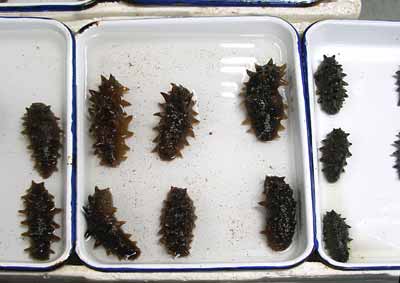
Trepang. Sea cucumber. An edible sea slug with tentacles at one end, treasured for its gelatinous texture in some parts of the world. It is usually available dried in the West, it should be soaked for 24 hours before use.
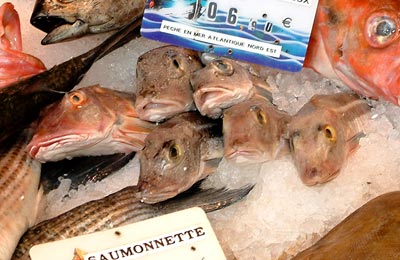
A name for tub gurnard. Gurnards are strange-looking, bottom-feeding fish which use the three bottom rays of their pectoral fins to "feel" the sea bed. They have firm-textured white meat with not much flavour. They are rich in protein, iodine and phosphorus. The tub gurnard is a large brownish-orange variety with bright orange pectoral fins and is the one most readily available in the United Kingdom. They are all very bony fish. Small ones are excellent in soup. Red or grey mullet (US: striped mullet) can generally be substituted for it, and are usually better.
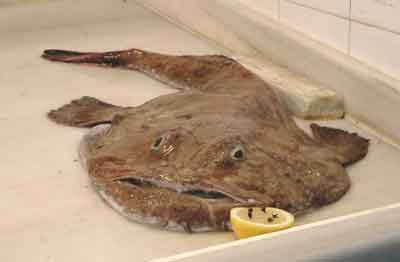
Monkfish (US: angler fish). A fish with a sweet flavour and succulent firm flesh but with the ugliest appearance imaginable. It is found in the Mediterranean and Atlantic, in coastal waters of north western Europe. It can be recognised by its large head and fan-shaped fins. The fins and the operculum are spiny. It can be eaten fried or in soup. The larger fish often have better flavour. It has a hideous head, which is why it is usually displayed without it, and a muddy colour. It is known as the anglerfish as it bears on its head a 'rod' and 'lure' which attract its prey. The meat of the tail is sweet and succulent - almost like lobster meat, entirely compensating for is appearance. The flavour may well be assisted by its own diet which is high in shellfish. The best monkfish are Lophius piscatorius and the similar Lophius budegassa, the favourite of the Spanish. American monkfish or goosefish (Lophius americanus) is considered inferior, while New Zealand monkfish (Kathetostoma giganteum) is related to the stargazer and is only fit for soup.
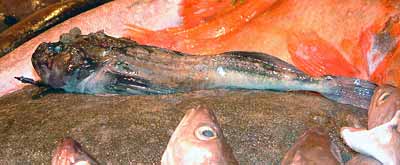
Sea scorpion. An ugly fish from North Atlantic waters. It has spines on its head which may be poisonous. Sea scorpions are occasionally used in fish soups.
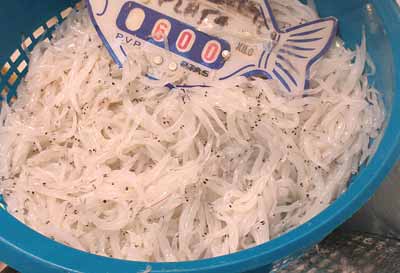
Fry, nicknamed sea spaghetti, are the minute, newly hatched young of atherines, whitebait, gobies, herring, sardines, sprats or anchovies. They are usually boiled or fried and served with olive oil and lemon juice, though they are also served in fritters or omelettes.
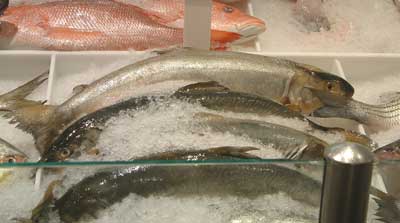
It is very confusing that sea trout is a name given to both the char(r) and for brown trout running at sea. Char(r) usually refers to the Arctic char, an uncommon freshwater fish of the same family as salmon, trout and related to grayling and the vendace or powan. It is found in rivers and lakes of northern Europe, north western United States and Canada and in the Great Lakes. They are migratory fish, like salmon and trout. They have a steely blue-grey back with salmon-pink speckles on the sides and a red underbelly. They have sweet firm flesh which varies from white to pink, dependent upon its own diet, and with good flavour, some say better than trout, being something like a cross between trout and salmon.